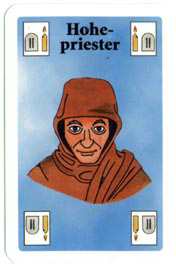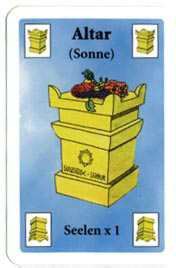|
|
|
|
T w i l i g h tbyWolfgang WernerGraphics: Robert Korschofski*** A tricky point trick game for three to four players ages 10 and up
|
Objective of the GameThe followers of the moon cult and the servants of the sun compete for human souls. Each side tries to win as many souls as possible for its cult.Additionally sanctuaries have to be built to guarantee success.
1 Twilight-card 28 gaming cards
14 cards of the sun cult
and 14 cards of the moon cult
Note: In the following the rules for four players are described first. The special rules for three players are located at the end of the instructions. |
Preparations for PlayTwo players at a time form a team. It is decided by lot who plays with whom. The members of one team sit opposite each other. The Twilight card is placed on the table in a way, that the two moon ends point to the moon players. If you like it, you can place a small tea light on the Twilight card.After shuffling and cutting the deck all 28 cards are distributed one at a time. In most of the cases each player will receive cards of the sun cult as well as cards of the moon cult. Sun and moon cards can be distinguished by the front side as well as by the back side.
Course of the GameThe player to the left of the dealer begins. He must either play a card of his appropriate cult or request another player to play a card on his behalf. This means e.g. a sun player has to choose whether he plays a card of the sun cult himself or whether he has someone else (this may be his partner as well as one of his opponents) play a sun card.Naturally only those players may be chosen, that hold at least one card of the choosing player's cult. If the chosen player holds more than one card of this cult, he may freely choose which of them he wants to play. In any case, the played card counts as if played by the player that chose who has to play the card. After a card is played the next player (after the one who chose who was to play) plays the next card or chooses a player to play the next card. Each time a player has to play a card moon players play a moon card or have someone play a moon card and sun players play a sun card themselves or have someone play a sun card. It is possible that a player is instructed more than once per turn to play a card. Therefore, it is not unusual that the players have a different number of cards in their hands.
|
The Twilight CardAll played cards are placed adjacent to the Twilight card in front of the player for whom the card was played. After the fourth card has been played the player with the highest card in front of him wins the trick. If there are more than one equally high cards in the trick, the card that was played first counts as being higher. The player who won the trick begins the next trick (by playing a card for himself or having another player play a card for him).Example below: Anton starts the trick. He instructs his partner Christian to play a moon card for him. Then Birgit demands a sun card from Anton. After this Christian wants Doris to play a moon card for him. At the end Doris plays a sun card for herself. Doris has played twice in the trick, whereas Birgit has played no card. Although each player played a card or had someone else play a card for him or her each player has a card in front of him or her which counts as his or her card.
|
Card OverviewThere are 14 moon- and 14 suncards. Each set consists of: 1 purgatory, 5 clerics, 5 souls und 3 sanctuaries.
If there are both purgatories in one trick, the first played purgatory begins the next trick. If a purgatory is played in the last trick of a game, then the tricks on the table remain there as neutral and do not count for any team.
Clerics: There are the cards Hierarch (I), High Priest (II), Priest (III), Adept (IV) and Novice (V). All clerics are higher than the souls. The order is as given above, the highest is the Hierarch.
Souls: On each card are between three and seven souls. Souls can be won only by clerics. All souls are equal concerning the trick height. This means, if there are four soul cards in a trick, the one played first wins the trick. The number of souls on the cards is only important for counting the souls after the game is finished. Please note the mistake on the card showing five souls. This is not a purgatory as it has been printed incorrectly on the card. (picture with german text)
Sanctuaries: There are the cards Obelisk, Temple and Altar. In the trick game all sanctuaries are equal in height, but even lower than the souls. In counting of the souls they count differently.
|
ScoringWhen all seven tricks are played, each team counts its souls.Soul cards count as their given value 3, 4, 5, 6 or 7. Each cleric has 1 soul. The type of card (sun or moon) does not matter for souls or clerics. The purgatory and the sanctuaries have no souls and therefore count 0. The sanctuaries, however, have an important function concerning the counting. All sanctuaries, that are in the own team at the end of the game are considered to be "built for the posterity" and multiply the value of the souls gathered by this team. If an altar has been built, all souls count once. If a temple has been built, all souls count twice and for the obelisk all souls count thrice. If an altar and a temple have been built, then all souls count thrice, for the altar and the obelisk four times, for the obelisk and the temple five times, and for all three sanctuaries six times. Sanctuaries, that are owned by the opposing team, are considered not built and count for no team. A team that could not build an own sanctuary receives no points (all souls multiplied by 0). If e.g. the sun cult has won two tricks with 7 souls (sun), 3 souls (moon), obelisk (sun), temple (moon), adept (sun), 4 souls (moon), hierarch (sun) and novice (moon), the resulting score is (7+3+0+0+1+4+1+1) x 3 = 51 points. The moon-temple has not been built for the sun cult, but it was prevented, that the moon cult could build it.
End of the GameThe game ends, if one team succeeds in scoring 1000 or more souls (=points). The winner is the team with the higher scoring.Of course, no communication of any sort is allowed between the players of one team during the entire game.
|
Rules for three playersWhen playing with three players, the moon player plays with two hands (one open and one closed hand) against the sun team. The game is a little more tactical than the four players' game.Therefore, the three players' game is easier, if you have already played the four players' game. But it is not absolutely necessary. In the three players' game there are no fixed teams. Each player takes his turn in playing alone. The seat opposite the player who plays alone remains vacant and will be called "new moon" in the following. The cards are dealt as in the four players' game. The new moon's cards lie open at the empty side of the table. The player playing alone begins the first trick. As in the four players' game he may play a moon card for himself or have someone else play a moon card for him. He is also allowed to choose the new moon to play a card for him. As moon player he may even choose this card himself. Vice versa, if it is the new moon's turn, he may also instruct himself to play a moon card for the new moon. I.e. if it is the new moon's turn or the turn of the player playing alone, the player playing alone may choose freely from the moon cards in his hand or the new moon's moon cards. If the player playing alone is advised to play a sun card, he has to choose one of the sun cards in his hand. If the new moon is advised to play a sun card, the player playing alone chooses one of the new moon's sun cards. After each dealing the player to the left of the player playing alone moves on to the new moon's seat. He deals the cards for the next round. The player to the right of the last player playing alone is the new player playing alone and plays the moon cards. The gained score is noted for each player separately. The game ends like in the four players' game, when one player (maybe even the new moon ?) scored at least 1000 points. If you like, you can play with fixed teams even in the three players game and tell us, whether you think the advantage lies with the player playing alone or with the sun team. |
Variant and tipsThe game ends when at least one of the teams succeeds in reaching one of the following goals:(1) The team's score is exactly 333 souls. (2) The team's score is exactly 666 souls. (3) The team's score is exactly 999 souls. (4) The team's score is 1000 souls or more. If both teams reach a goal simultaneously, the given winning order is the order given above. If both teams reach goal (4), thus having more than 1000 souls, the team with the higher score wins. Tip 1: It is important to memorize, which cards have already been played, and which cards are still in the game. Tip 2: It is generally good to have the opponent play a card for yourself, if the own partner is the last to play a card in the trick. More tips are not given, but it is simply noted, that the first TWILIGHT test game ended 333 to 376 in favor of the sun cult. The author, Wolfgang Werner |
|
|
|
|
 |
   
Bambus Spieleverlag Günter Cornett | Kopfstraße 43 | D-12053 Berlin Phone/Fax: +49-30-6121884 |
| just archiv data +++ no orders +++ German infos Archiv-Seite +++ nicht aktuell +++ keine Bestellungen! Infos hierzu sowie aktuelles Impressum: www. bambusspieleverlag. de |

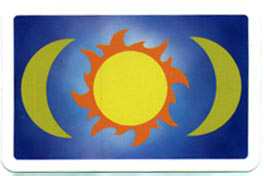
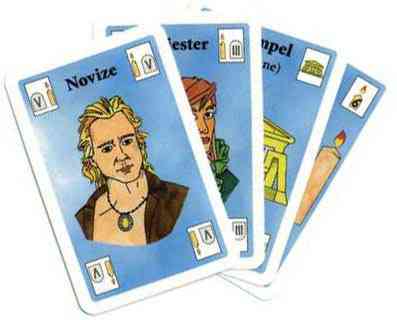
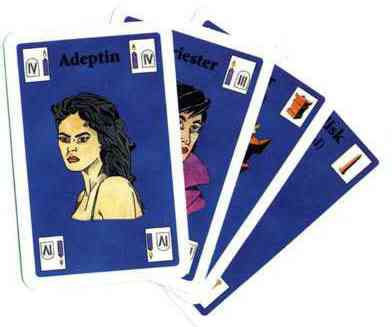
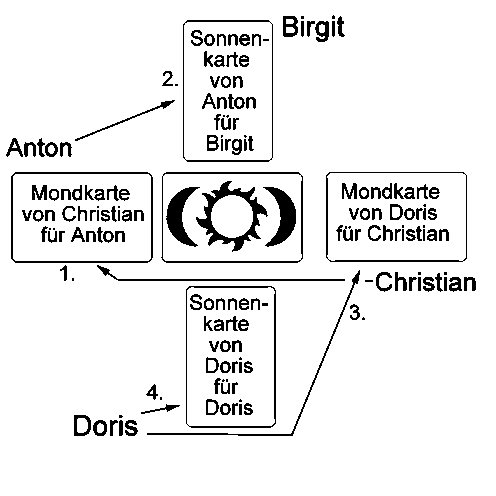 Considering the cards already played in the current trick, it is always clear who has to choose who plays the next card.
Considering the cards already played in the current trick, it is always clear who has to choose who plays the next card.
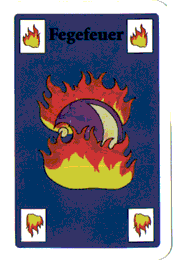 The purgatory is the highest card in play. However, it is not possible to win a trick with this card. If the purgatory is played, the current trick remains on the table until the next trick is evaluated. The player who played the purgatory begins the next trick. The winner of this next trick also wins the trick with the purgatory.
The purgatory is the highest card in play. However, it is not possible to win a trick with this card. If the purgatory is played, the current trick remains on the table until the next trick is evaluated. The player who played the purgatory begins the next trick. The winner of this next trick also wins the trick with the purgatory.